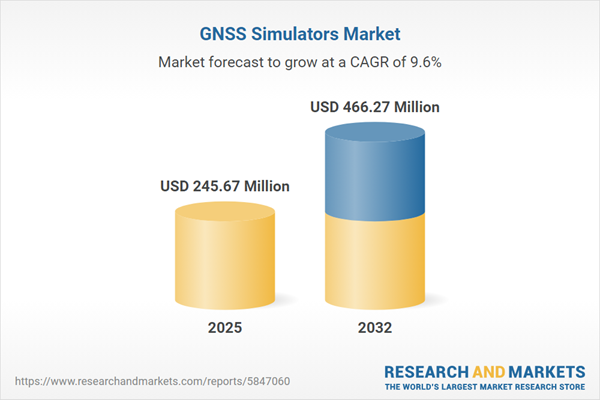Speak directly to the analyst to clarify any post sales queries you may have.
The GNSS simulators market is gaining traction as organizations face heightened demands for secure, dependable navigation technologies. Senior decision-makers are prioritizing resilience, compliance, and innovation, making advanced simulation solutions a critical asset in operational strategy.
Market Snapshot: GNSS Simulators Market Growth and Key Trends
The GNSS simulators market achieved robust growth, expanding from USD 224.56 million in 2024 to USD 245.67 million in 2025, with projections indicating a reach of USD 466.27 million by 2032 and a CAGR of 9.56%. Demand across aerospace, automotive, and consumer electronics sectors supports this trajectory, as simulation advances help companies meet stringent requirements for reliability and regulatory scrutiny. Innovative software-defined architectures and the adoption of AI-driven features are enhancing simulation accuracy and system adaptability. Cloud-native approaches are influencing how companies develop and deploy simulation products. Across geographies, organizations are prioritizing security, compliance, and deployment flexibility to adapt to new operational and legislative demands.
Scope & Segmentation of the GNSS Simulators Market
This report presents an extensive analysis of the GNSS simulators market for strategic planning and investment. Senior leaders will find actionable insight into technology, regions, applications, and distribution dynamics.
- Applications: Aerospace and defense guidance; automotive driver assistance and fleet management; consumer electronics such as smartphones and wearables; telecommunications for network synchronization; and diverse location-based services. Each area fuels unique requirements for simulation testing to ensure navigation system resiliency.
- Product Types: Hardware platforms supporting real-time and playback functions; consulting and maintenance services; and specialized software for scenario-based signal simulation. Each product category enables precise procurement and integration decisions for varied operational contexts.
- End Users: Aerospace and defense agencies, automotive manufacturers, consumer electronics providers, defense service contractors, academic and research organizations. Adoption rates differ by sector, shaped by the technical sophistication and mission-criticality of applications.
- Technologies: Multi-frequency solutions including dual-frequency and triple-frequency options, alongside single-frequency devices such as L1-only or L5-only units. Selection guides organizations in balancing mission accuracy with cost expectations.
- Distribution Channels: Direct sales to OEMs and integrators; authorized distributors for vertical markets; and specialized third-party resellers. Effective distribution models ensure timely market access and continuous support.
- Form Factors: Benchtop modules for laboratory testing, portable solutions tailored for mobile or vehicle deployment, and rack-mounted hardware suited for both standard and tailor-made integration.
- Frequency Bands: L1 and L5 bands targeting precision navigation and synchronized compliance with diverse application requirements.
- Regions: Americas, Europe, Middle East and Africa, Asia-Pacific. Each presents distinctive regulatory frameworks, operational environments, and rates of GNSS simulator adoption, impacting procurement and deployment strategies.
Key Takeaways for Senior Decision-Makers
- Cloud-native GNSS simulator solutions and AI-based features are boosting adaptability, enabling organizations to prototype and validate highly complex navigation scenarios rapidly.
- Advanced simulation platforms are supporting rigorous testing for autonomous navigation, enhancing mobility offerings, and underpinning scalable implementation of IoT deployments while ensuring robust navigation dependability.
- Changing supply chain considerations and shifting regulations are driving organizations to adopt more flexible sourcing models and reinforce operational resilience to minimize risks related to regional interruptions.
- Strong collaboration between hardware manufacturers, chipset vendors, satellite operators, and cybersecurity experts is essential for reducing vulnerabilities, including signal spoofing and unauthorized system access.
- Subscription-based procurement models enable organizations to optimize costs while meeting compliance and adapting to diverse regulatory environments and service expectations across locations.
Tariff Impact: GNSS Simulator Supply Chains and Industry Economics
Recent shifts in tariffs, especially in the United States, are impacting the GNSS simulators industry by increasing costs of critical components and spurring companies to localize and regionalize manufacturing operations. Organizations are investing in domestic production to secure supply reliability, while managed services providers expand their offerings to guide clients through these transitions. Flexible sourcing has become a necessity as firms navigate an increasingly unpredictable economic environment.
Methodology & Data Sources
This report utilizes primary interviews with key industry stakeholders and decision-makers, strengthened by secondary research from trusted publications. All findings have been subjected to thorough triangulation and peer review, ensuring an accurate and balanced view of the technical, regulatory, and commercial aspects shaping the GNSS simulators sector.
Why This Report Matters
- Empowers leaders to align technology investments and partnership strategies with changing compliance and market demands, enabling proactive decision-making.
- Helps organizations untangle complex supply chains while allowing for the adoption of flexible business models suited to evolving procurement requirements in the GNSS simulators space.
- Provides detailed analysis of regional differences, equipping firms to craft strategies that meet various regulatory obligations and customer preferences.
Conclusion
GNSS simulators are essential for supporting risk management, regulatory compliance, and operational resilience. With the strategic insights detailed here, organizations can lead confidently through ongoing technological and legislative change.
Additional Product Information:
- Purchase of this report includes 1 year online access with quarterly updates.
- This report can be updated on request. Please contact our Customer Experience team using the Ask a Question widget on our website.
Table of Contents
3. Executive Summary
4. Market Overview
7. Cumulative Impact of Artificial Intelligence 2025
List of Figures
Samples

LOADING...
Companies Mentioned
The key companies profiled in this GNSS Simulators market report include:- Rohde & Schwarz GmbH & Co. KG
- Keysight Technologies, Inc.
- Spirent Communications plc
- National Instruments Corporation
- VIAVI Solutions Inc.
- Orolia SA
- Racelogic Ltd
- Astronics Corporation
- Spectrum Instrumentation GmbH
- Barcan Technology Ltd
Table Information
| Report Attribute | Details |
|---|---|
| No. of Pages | 190 |
| Published | October 2025 |
| Forecast Period | 2025 - 2032 |
| Estimated Market Value ( USD | $ 245.67 Million |
| Forecasted Market Value ( USD | $ 466.27 Million |
| Compound Annual Growth Rate | 9.5% |
| Regions Covered | Global |
| No. of Companies Mentioned | 11 |









